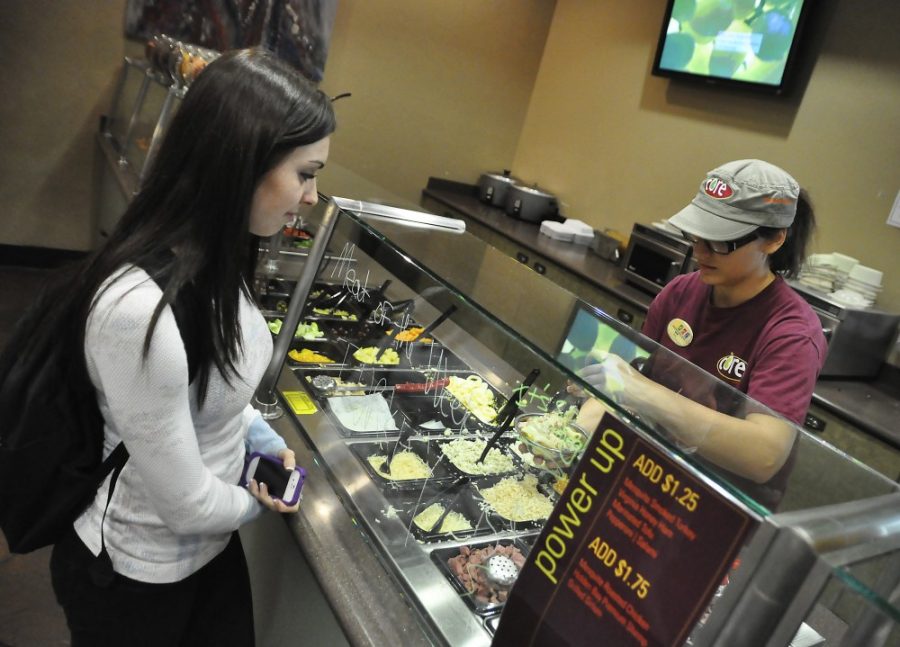Eating in college means looking for the best deal and price, rather than the quality of food. With options such as $3 burritos, $1 nachos and free sundaes with purchase — who wouldn’t want to save a buck or two? Many students, however, visit University Boulevard to mix up their culinary options. But looking into the health ratings of our favorite restaurants may reveal that the overlooked union food eateries are cleaner than some of those off campus.
Pinkberry’s arrival on Feb. 14 will add another eatery into a place with “excellent” Pima County Health Department ratings. Though some University Boulevard restaurants are working on getting their recent ratings from “good” or “adequate” to “excellent,” the union’s restaurants and eateries have been maintaining excellence for the past three years.
The health department lays out its ratings in straightforward detail. During random inspections, inspectors evaluate restaurants based on a range of violations and codes including temperature controls, contamination prevention, waste disposal and employee health and hygiene. Grades range from “E” for excellent, “G” for good, “N” for needs improvement, and of course, the dreaded “F” for fail.
According to Timothy Stevens, supervisor of Arizona Student Unions Dining Services, the Student Union Memorial Center’s “excellent” health ratings are the result of a new training program for student union food workers.
Before starting on the job this semester, student workers were required to attend a day-long training session, which included interactive education on the specific sanitation and health codes set by the Pima County Health Department. Unlike the online tutorials of past years, Stevens says that these hands-on sessions are more effective because they better prepare employees and keep them up-to-date with expectations.
Rachel Pergamit, an environmental resource economy major, has worked at Core for the past two and a half years. Pergamit said the training was long but important — employees learn everything from adequate food handling, to proper storage temperatures and techniques for preventing cross-contamination of food and chemicals.
“It’s not hard to maintain cleanliness,” Pergamit said.
She added that after intense training both in sessions and through experience on the job, upholding health standards becomes second nature.
Scott Buscemi, a management information systems major, said he is not surprised by the excellent ratings at the union because smaller off-campus restaurants may have fewer resources to spend on sanitation concerns.
In the spring of 2010, an inspection at Fuku Sushi revealed that “food contact surfaces and equipment are not cleaned frequently and properly to prevent food contamination.” In addition, not all food contact surfaces were sanitized properly, and “all foods are not from approved sources, safe, unadulterated or honestly presented.”
Adam Nathel, a history major, said he used to frequent a local Sonoran hot dog cart offcampus. But after a health inspection report about the cart said “potentially hazardous foods not held at proper cooling temperature,” this past June, Nathel said he decided to be more cautious about where he eats.
For this reason, Nathel said restaurants should be required to post their inspection ratings. He explained that in his hometown of New York, restaurants must clearly display the grade of “A,” “B,” “C,” “D,” or “F” for customers upon entrance.
Stevens added that of course health department inspections do not intend to damage restaurants’ reputations or put them out of business. But it’s the department’s job to hold restaurants accountable, and keep customers safe with open, honest and detailed expectations.
In addition to the standards upheld by the Pima County Health Department, the student union also has its own safety and sanitation department. These regulations ensure that workers properly utilize dishwashing stations, and clean large machinery such as char broilers and fryers multiple times a day.
Even after the union closes each night, late-night crew cleaners perform even more sanitation, from polishing floors to the nitty gritty, Stevens said.
“We run a pretty tight ship,” Stevens said. Every staff member goes through the same level of training, Stevens said, so everyone is responsible for keeping the restaurants sanitary and maintaining excellent ratings.









